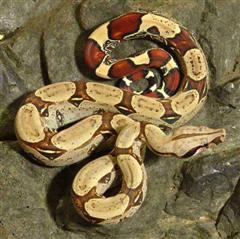Boa - Peruvian Red Tail
Mantona Scientific Name: Boa constrictor constrictor
Mon, 28th April, 2025 - 7:57 am GMT
Sponsor Ads:

Alternative Name
Mantona Scientific Name: Boa constrictor constrictorBasic Info
This beautiful Boa Constrictor is colored brilliantly with light pinks, tans, and dramatically deep reds that highlight the tail and a few areas on the snake's back. They are large, hardy snakes that can grow eight to ten feet in length.
Health
Peruvian Red Tailed Boas are tropical reptiles. You should keep their cage at 80 to 85 degrees Fahrenheit during the day, with a basking spot about 90 to 95 degrees Fahrenheit. At night the cage should be about 10 degrees cooler. Humidity should be maintained at about 50 to 80 percent. Mature Peruvian Red Tailed Boa Constrictors should be housed in a relatively large enclosure. Since they spend time both in trees and on the ground in the wild, provide them with a sturdy climbing branch as well as ground space. Peruvian Red Tails love to soak and should have a bowl large enough for them to coil up in. Unfortunately, Red Tail water bowls usually require frequent cleaning because the snakes tend to defecate while soaking. Captive Peruvian Red Tail Boas should be fed appropriately sized rodents. Small to medium sized boas will eat mice and rats, which are relatively cheap and easy to obtain. Be advised, however, that Red Tailed Boas grow very quickly when properly maintained, and will need to be fed larger mammals such as guinea pigs and rabbits, which can be more costly and difficult to procure in certain areas or at certain times of the year. It is a good idea to feed pre-killed rodents, as they cannot bite back. Immature boas should be fed about once every seven to ten days. As adults, they do not need to eat quite as frequently.Habitat
N/ABehavior
A fascinating snake to keep in your home, the Peruvian Red Tailed Boa Constrictor can make an excellent pet. Peruvian Red Tailed Boa Constrictors can be fairly non-aggressive and calm, if they are handled regularly. They are generally not fussy feeders. Because of their adult size, keeping large boids like the Peruvian Red Tailed Boa Constrictor can be difficult for even the most seasoned of snake keepers. In the wild they will eat mammals and birds.Origin
South AmericaHistory
Almost all boa constrictors can be labeled "red tailed" because most have reddish tails. The species Boa constrictor contains many varieties, which differ slightly in color and/or markings. Though most people do not make a taxonomic distinction between the South American Boa Constrictors, true Red Tails are less common and more expensive than the common variety. Make sure you know which you are buying. In Peru these snakes are often called "Mantona".Common Foods
N/ASponsor Ads:
I believe the greater the handicap, the greater the triumph. --John H. Johnson
Boa - Peruvian Red Tail
Coded by: BGID® | ALL RIGHTS RESERVED Copyright © 2000-2025
Disclaimer | Privacy | Report Errors / Contact | Credits








 Why haven't we as a collective earth met with aliens yet?
Why haven't we as a collective earth met with aliens yet?  The Best Text Adventure You Will Ever Play! The official site:
The Best Text Adventure You Will Ever Play! The official site:  Homosexual behavior stems from the mind or genetics?
Homosexual behavior stems from the mind or genetics?  World EcoSystem - Biodiversity Changes - Who is on board and who isn
World EcoSystem - Biodiversity Changes - Who is on board and who isn  Mouthwash - Mouthrinse - Mouth Sores - Healing Infections - Gingivitis
Mouthwash - Mouthrinse - Mouth Sores - Healing Infections - Gingivitis  Treatment for Depression
Treatment for Depression  Ultra radical and violent Islamist group that even rivals Al Qaeda
Ultra radical and violent Islamist group that even rivals Al Qaeda  An idea to have teachers who want to carry guns to school undergo some level of police training will be left up to local school districts and police departments.
An idea to have teachers who want to carry guns to school undergo some level of police training will be left up to local school districts and police departments.